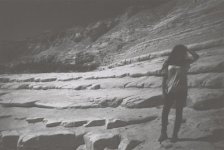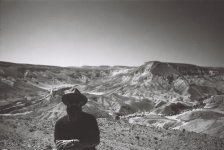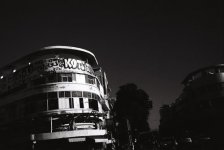robglickman
Member
Hi all,
Recently tried some Rollei Retro 80s with my Leica M7, 35 Summilux pre-asph and a B&W Series 7 yellow filter ..
I had the film processed in a lab in Israel that I had never used before ..
The results were not what I expected ..
Can anyone tell me what went wrong?
Trying to upload a few examples ..
Thanks in advance ..
Recently tried some Rollei Retro 80s with my Leica M7, 35 Summilux pre-asph and a B&W Series 7 yellow filter ..
I had the film processed in a lab in Israel that I had never used before ..
The results were not what I expected ..
Can anyone tell me what went wrong?
Trying to upload a few examples ..
Thanks in advance ..
Attachments
Swift1
Veteran
Hi all,
Recently tried some Rollei Retro 80s with my Leica M7, 35 Summilux pre-asph and a B&W Series 7 yellow filter ..
I had the film processed in a lab in Israel that I had never used before ..
The results were not what I expected ..
Can anyone tell me what went wrong?
Trying to upload a few examples ..
Thanks in advance ..
Looks underexposed or maybe under developed to me...
spaceistheplace
Established
Did you compensate for the filter?
Timmyjoe
Veteran
First one looks underexposed, second one looks closer on exposure, but the harshness of the mid-day sun and his hat seems to have kept any light from reaching his face, and the last one seems again to be about proper exposure but the harshness of the light makes for pretty intense contrast. If these were all on the same roll, I'd say exposure might be the issue. If they were on three different rolls, in the order you have them shown, I'd say the first roll was underdeveloped, second closer to proper development, third overdeveloped. Then it would be a processing issue with the lab.
Best,
-Tim
Best,
-Tim
robglickman
Member
Did you compensate for the filter?
I had the shutter set to 'auto', expecting the camera to compensate on it's own ..
BLKRCAT
75% Film
keep in mind that retro 80s has extended red sensitivity. This would change your filter factor especially with a yellow.
gnuyork
Well-known
I had the shutter set to 'auto', expecting the camera to compensate on it's own ..
Wouldn't you still need to compensate for filter factor with an M7 rangefinder, even set on auto shutter? I've never used an M7, I'm just asking.
Edit: Never mind. For some reason I was thinking metering was not through the lens...
Roger Hicks
Veteran
Possibly excess red sensitivity of the meter, leading to underexposure?
Cheers,
R.
Cheers,
R.
Robert Lai
Well-known
The M7 has a TTL meter, so the filter's light reduction is compensated for automatically. However, you have to realize that the M7 has a "fat spot" type meter. On all of the pictures that you've shown, you have very bright hightlights in the background. I suspect that the meter is trying to give you the correct exposure for the bright background. This is most evident in your 3rd picture, because the brightly lit facade of the building is correctly exposed. Too bad for everything else. In your other pictures also, you put the subject off center (rule of thirds?), so the meter takes a nicely exposed picture of the background in the center of the frame.
Here the well delineated spot meter of the M5 is useful, because the spot reading area of the meter is actually outlined in the viewfinder. Also, the older non-metered M cameras, if they use the Leicameter MR-4, can use the 90mm frame line to define the metering area. The MR-4 has a built in angle of view to match the 90mm lens. Hence, another fat spot meter.
Realize also that in full blazing Middle Eastern sun, you have a huge contrast range from deep shadow to full bright white. No film, even B&W film, can handle the 15+ stops of contrast. You're going to lose something somewhere.
So, how to handle this situation?
1) Move up close and meter your subject. If you can't get close enough, then use an incident light meter in the same lighting as your subject to see how much light is falling upon it.
2) Pick a time of day when the contrast range is not so extreme: dawn, dusk, or whenever you have overcast or heavily cloudy skies.
3) Fill in flash. It seems that you like backlighted subjects. In that case, for your M7 invest in a Metz SCA 3502 adapter and put it on a Metz flash that supports high speed synch flash (HSS), such as the Metz 54MZ-4. This is the setup I use, for less intense Midwestern and Southern US sun. You are limited to shutter speeds of 1/250, 1/500. and 1/1000 for HSS. And, flash exposure is manual, based on guide numbers. Don't fret - you focus on your subject, and find the distance (on your focus ring of your lens). Then you can adjust the flash's power levels until the readout matches the aperture that you are shooting at.
4) Assistant with portable reflectors - the way pros do it. Anything to throw more light onto your subject and reduce the contrast range.
Here the well delineated spot meter of the M5 is useful, because the spot reading area of the meter is actually outlined in the viewfinder. Also, the older non-metered M cameras, if they use the Leicameter MR-4, can use the 90mm frame line to define the metering area. The MR-4 has a built in angle of view to match the 90mm lens. Hence, another fat spot meter.
Realize also that in full blazing Middle Eastern sun, you have a huge contrast range from deep shadow to full bright white. No film, even B&W film, can handle the 15+ stops of contrast. You're going to lose something somewhere.
So, how to handle this situation?
1) Move up close and meter your subject. If you can't get close enough, then use an incident light meter in the same lighting as your subject to see how much light is falling upon it.
2) Pick a time of day when the contrast range is not so extreme: dawn, dusk, or whenever you have overcast or heavily cloudy skies.
3) Fill in flash. It seems that you like backlighted subjects. In that case, for your M7 invest in a Metz SCA 3502 adapter and put it on a Metz flash that supports high speed synch flash (HSS), such as the Metz 54MZ-4. This is the setup I use, for less intense Midwestern and Southern US sun. You are limited to shutter speeds of 1/250, 1/500. and 1/1000 for HSS. And, flash exposure is manual, based on guide numbers. Don't fret - you focus on your subject, and find the distance (on your focus ring of your lens). Then you can adjust the flash's power levels until the readout matches the aperture that you are shooting at.
4) Assistant with portable reflectors - the way pros do it. Anything to throw more light onto your subject and reduce the contrast range.
Huss
Veteran
From bhphoto:
"Rollei's Retro 80S is a slow-speed panchromatic black and white negative film with extended near-infrared sensitivity to 775nm. This additional red sensitivity helps to cut through haze or fog and also smooth skin tones and blemishes, making it ideal for portraiture. It has a nominal sensitivity of ISO 80/20° and is characterized by a fine grain structure and broad tonal range."
Also- did u set the film speed correctly on your M7? I don't think this film has DX coding (I may be wrong) and so if u did not set it manually, the default setting would have resulted in underexposure.
"Rollei's Retro 80S is a slow-speed panchromatic black and white negative film with extended near-infrared sensitivity to 775nm. This additional red sensitivity helps to cut through haze or fog and also smooth skin tones and blemishes, making it ideal for portraiture. It has a nominal sensitivity of ISO 80/20° and is characterized by a fine grain structure and broad tonal range."
Also- did u set the film speed correctly on your M7? I don't think this film has DX coding (I may be wrong) and so if u did not set it manually, the default setting would have resulted in underexposure.
sevo
Fokutorendaburando
Possibly excess red sensitivity of the meter, leading to underexposure?
Given that Rollei 80S is a traffic film, its red sensitivity ought to be higher than that of the meter. Some IR films are essentially blue/red sensitive only in the visible range, where a yellow-green filter might cut off most of the spectrum the film is sensitive to, while the meter sensor will be (colour film) neutral - that might cause significant underexposure.
Huss
Veteran
Online reviews have suggested to rate it at ISO 50 for best results. If the OP had set it at 100 (camera default for non DX film) then it's already 1 stop underexposed.
Roger Hicks
Veteran
Not any more, I think. I'd also want to see spectral sensitivity curves before asserting that an extended-red traffic film is more sensitive to red than some metering cells.. . . Some IR films are essentially blue/red sensitive only in the visible range, . . . .
Cheers,
R.
BLKRCAT
75% Film
charjohncarter
Veteran
If you look at 80s the red sensitivity goes strongly to about 775 nm, while Foma Classic 100 (Arista EDU ultra 100) the red sensitivity stops at about 680 nm. But 80s take a steep dive in the blue are at about 340 nm. And the Foma 100 takes a slow dive in the blue spectrum starting at 600 nm which means it is way less blue sensitive. That, of course, are individual film characteristics. I don't use 80s but I have to use an Orange filter with the Foma 100 to get anything less than a blow out with blue sky in California or (in your case) Israeli sunshine.
The 80s is recommended for portrait and nude photography and because of its high red spectrum (approaching IR) maybe it isn't the best film for Israel. If you wanted to use it for some reason outdoors maybe not even a Yellow filter. But more important a lab may not be the best choice for development (or printing) of this film. I'm sure this is an acceptable film within its restrictions but maybe not one to take to a Lab.
This is supported by your last photo which shows very dark skies which is expected from 80s's spectral curves.
http://www.maco-photo.de/files/images/The_Rollei_RETRO_80s_AJ.pdf
http://www.foma.cz/en/fomapan-100
The 80s is recommended for portrait and nude photography and because of its high red spectrum (approaching IR) maybe it isn't the best film for Israel. If you wanted to use it for some reason outdoors maybe not even a Yellow filter. But more important a lab may not be the best choice for development (or printing) of this film. I'm sure this is an acceptable film within its restrictions but maybe not one to take to a Lab.
This is supported by your last photo which shows very dark skies which is expected from 80s's spectral curves.
http://www.maco-photo.de/files/images/The_Rollei_RETRO_80s_AJ.pdf
http://www.foma.cz/en/fomapan-100
Roger Hicks
Veteran
Thanks, but in the absence of the meter cell sensitivity curve it doesn't really say much: mainly, that it's a typical extended-red "traffic" film.
Of course the response of the M7 meter is further affected by the fact that it's reading the light bounced off the big white spot. How much IR that absorbs will still further complicate matters.
Cheers,
R.
:: Mark
Well-known
FWIW, I find that I need to overexpose the M7 by 1/3 to 2/3 of a stop when shooting with a deep red filter (B&W 091). However, this is usually with Delta 100 which does not have much sensitivity at the low-frequency end of the spectrum.
I think that the only way to be sure is to shoot at least one film with some bracketing...
(And yes, beware bright point-like highlights anywhere near the frame center when metering with the M7!)
I think that the only way to be sure is to shoot at least one film with some bracketing...
(And yes, beware bright point-like highlights anywhere near the frame center when metering with the M7!)
robglickman
Member
First one looks underexposed, second one looks closer on exposure, but the harshness of the mid-day sun and his hat seems to have kept any light from reaching his face, and the last one seems again to be about proper exposure but the harshness of the light makes for pretty intense contrast. If these were all on the same roll, I'd say exposure might be the issue. If they were on three different rolls, in the order you have them shown, I'd say the first roll was underdeveloped, second closer to proper development, third overdeveloped. Then it would be a processing issue with the lab.
Best,
-Tim
I think you may be correct on the development being an issue .. Thanks Tim ..
robglickman
Member
Thanks, but in the absence of the meter cell sensitivity curve it doesn't really say much: mainly, that it's a typical extended-red "traffic" film.
Of course the response of the M7 meter is further affected by the fact that it's reading the light bounced off the big white spot. How much IR that absorbs will still further complicate matters.
Cheers,
R.
Thanks Roger, but what is "traffic film" ?
robglickman
Member
If you look at 80s the red sensitivity goes strongly to about 775 nm, while Foma Classic 100 (Arista EDU ultra 100) the red sensitivity stops at about 680 nm. But 80s take a steep dive in the blue are at about 340 nm. And the Foma 100 takes a slow dive in the blue spectrum starting at 600 nm which means it is way less blue sensitive. That, of course, are individual film characteristics. I don't use 80s but I have to use an Orange filter with the Foma 100 to get anything less than a blow out with blue sky in California or (in your case) Israeli sunshine.
The 80s is recommended for portrait and nude photography and because of its high red spectrum (approaching IR) maybe it isn't the best film for Israel. If you wanted to use it for some reason outdoors maybe not even a Yellow filter. But more important a lab may not be the best choice for development (or printing) of this film. I'm sure this is an acceptable film within its restrictions but maybe not one to take to a Lab.
This is supported by your last photo which shows very dark skies which is expected from 80s's spectral curves.
http://www.maco-photo.de/files/images/The_Rollei_RETRO_80s_AJ.pdf
http://www.foma.cz/en/fomapan-100
Thanks for your reply .. What film would you suggest for Israel or any bright, desert type of environment?
Share:
-
This site uses cookies to help personalise content, tailor your experience and to keep you logged in if you register.
By continuing to use this site, you are consenting to our use of cookies.



